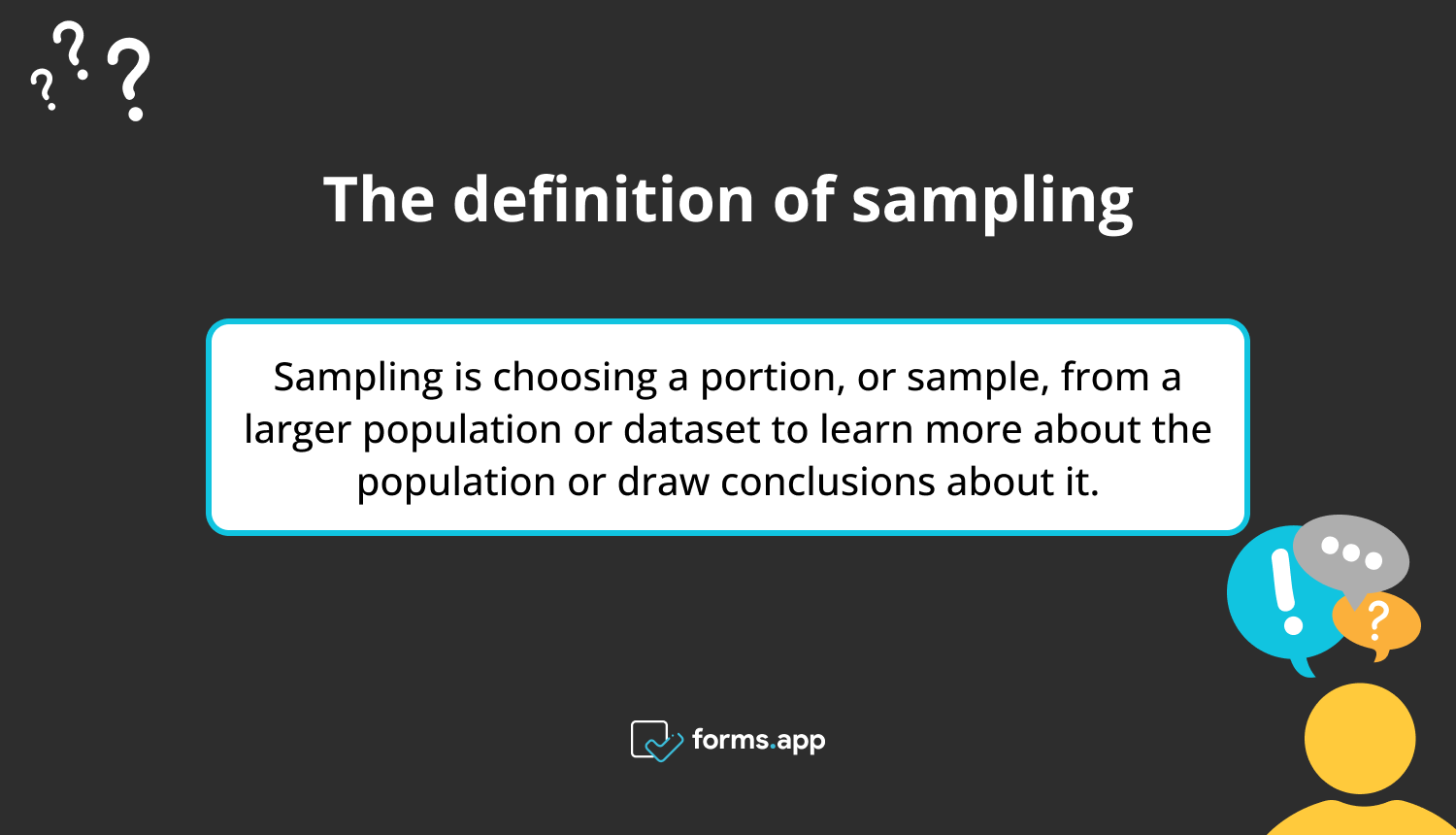The target population for certain studies may be as vast as all people. It is only feasible to get data from some members of a group of individuals when researching them. In its place, you pick a sample. The population that will take part in the study is the sample.
Sampling is a crucial part of every research study. Various sampling techniques exist depending on your research group. This article will explain the definition of sampling, the fundamental terminology used in survey sampling, and frequently asked questions regarding survey sampling terms.
First things first: What is sampling?
In statistical analysis, sampling is the procedure by which researchers choose a specific number of observations from a larger population. Researchers can study a massive group by employing a tiny population sample through sampling.

The definition of sampling
Researchers can make inferences and observations by selecting a representative sample from a broader population. By using a smaller number of people with typical traits to represent the entire population, sampling enables large-scale research to be conducted within more realistic financial and time constraints.
In layman’s terms, sampling is choosing a portion, or sample, from a larger population or dataset to learn more about the population or draw conclusions about it. It entails selecting a sample that is both representative and adequately reflects the traits of the people of interest.
All the essential terms in survey sampling
It makes sense to utilize sampling techniques in research projects of various shapes and sizes, even if sampling is easier to comprehend when considering a vast population. Before understanding the different sample strategies, you must learn basic technical terms related to sampling.
1 - Population
The term “population” in the sampling context refers to the group of people or things the researcher is interested in examining. A sample is taken from the larger group to infer or derive conclusions about the traits of the entire population.
Simply put, a population is an entire group of humans you research and from whom you want to conclude. Numerous factors may be used to describe the population, including age, gender, location, and educational level.
2 - Target population
The target population is the population for which the intervention is intended to be studied and drawn. When conducting a research study, the target audience's characteristics and subgroups should be detailed.
In layman’s terms, in sampling, the term “target population” refers to a particular set of people or things the researcher wishes to conclude about. It is an image of the larger population from which a sample was taken.
3 - Study population
The study population is a group that is considered in statistical analysis. The research population is not just comprised of people. It is a collection of features that are connected in some way.
In a nutshell, the study population is the entire group of people you consider for your research. The study population is a segment of the target population from which the sample is drawn. It goes beyond the scope of the idea sample frame.
4 - Sample frame
The sample frame is a collection of the elements from which you will draw samples. The sample frame may be the same as the population or a subset in certain circumstances. The sample frame must reflect the whole population.
In short, a sampling frame is a list of every member of the whole population. The sampling frame must be as comprehensive as possible so that your sample appropriately reflects your population.
5 - Sample
A sample is a more miniature, manageable representation of a larger group. It is a subset of a more significant population's features. When the population size is too vast for the test to include all potential members or observations, samples are employed.
To put it simply, a sample is a subset of data collected from a larger population by a researcher. A sample should be representative of the entire population and should not be biased toward any one trait.
6 - Unit
A unit is an individual item or person considered singular and complete but may also be a particular component of a bigger or more complicated whole. Some or all of these units are selected as samples for further examination and deduction.
7 - Sample size
The sample size is the number of objects or individuals selected from a population to participate in a research study or survey. It refers to the total number of participants or observations in the data-gathering procedure.
In layman's terms, the sample size is the number of completed replies to your survey. The sample size is critical in establishing the accuracy and dependability of the study's results or conclusions.
8 - Strata
A stratum is a population segment formed by combining more or less homogenous units, and strata are the plural form of the stratum. During stratified random sampling, items are sorted into strata.
In a nutshell, strata are subsets of a population or sample frame. Stratification aids in mistake reduction.
9 - Generalizing
Generalizing is the extent to which you may adapt your research findings to a larger context. When research findings can be applied to most circumstances, most individuals, most of the time, are termed generalizable.
10 - Sampling error
A sampling error occurs when a researcher needs to choose a sample that accurately represents the complete data population. Although sampling errors are common, researchers usually incorporate a margin of error in their results as a matter of statistical practice.
In layman's terms, a sampling error happens when the study's sample reflects a partial population. Sampling error is when the samples are not genuine representations of the people.
11 - Oversampling
Oversampling happens when you examine the same individual repeatedly. In statistics, it includes obtaining larger, disproportionate samples than would otherwise be acquired by random sampling.
12 - Sampling distribution
A sampling distribution is a statistical probability distribution derived from repeated population sampling. It outlines a statistical statistic's probable outcomes.
Frequently asked questions about survey sampling terms
Population vs. sample
Population refers to the people or items a researcher wants to investigate. It is rather large and comprises all of the group's potential members.
Conversely, a sample is a smaller subset of the population used to derive conclusions about the overall population. It is a subset of the people picked via sampling.
The sample features are utilized in statistical analysis to conclude the characteristics of the population. To reduce sampling bias and maximize the generalizability of the findings, sampling seeks to pick a representative sample that correctly represents the characteristics of the community.
Sampling frame vs. population
The population is the complete set of people or objects you want to learn more about. It is the total group about whom you wish to make conclusions. On the other hand, the sampling frame is a list of the sampling units that will be contacted for inclusion in the sample.
The distinction between a population and a sampling frame is that the population is broad and narrow. The population is all of the individuals or things to whom you want to generalize the results of your investigation. In contrast, a sample frame is a subset of a population and the individuals or objects you can access.
Population parameter vs. sample statistic
In statistics, a population or sample is described using two key concepts: a population parameter and a sample statistic.
In contrast to sample statistics, which are numerical values that describe a feature of a sample, population parameters are numerical values that define a characteristic of a population.
The main distinction between a population parameter and a sample statistic is that the former refers to the entire population, while the latter refers to a sample of the people.
Final words
Sampling uses a population sample to represent the entire population in survey research. Although the selection is easiest to grasp when considering a vast population, sampling procedures make sense in all sorts and sizes of research investigations.
As a smaller subset of the population with representative traits is used to represent the entire population, sampling allows large-scale research to be undertaken within a more realistic budget and time restrictions.
This article has explained the definition of sampling, the fundamental terminology used in survey sampling, and common questions regarding survey sampling terms.
forms.app, your free form builder
- Unlimited views
- Unlimited questions
- Unlimited notifications



